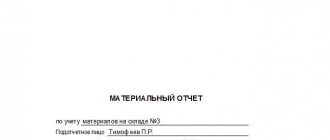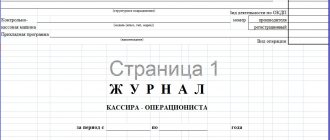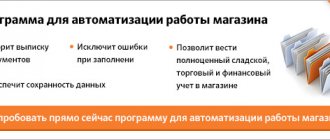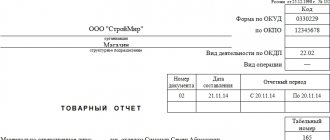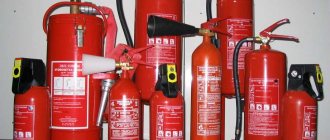What is this document for?
A cashier's certificate report is a document that indicates the readings of the cash register device at the time the cash register is closed, and the amount of money that is transferred to the chief cashier, accountant or director of the enterprise for a certain period (working day, shift, working week, month or quarter) .
The cashier's report is a mandatory document, in accordance with the legislation of the Russian Federation, for all legal entities, individual entrepreneurs, and any other persons who carry out business activities using a cash register. It is on the basis of reports that you can quickly and correctly draw up a report for a certain period, for example, a month or six months. And one more important purpose - it is on the basis of such reports that an entrepreneur or legal entity can report to government organizations.
https://www.youtube.com/watch?v=16VX1VxkOFg
If the company is very small, then the cashier can transfer the proceeds for a certain period of time directly to the bank. Then the money goes to the account from where purchases are paid, salaries and taxes are paid.
The cashier's reporting documentation is drawn up only on those days when a certain cash flow occurs through the cash register. For example, when money is withdrawn from the cash register or when paying wages.
The report, which was completed by the cashier, is an exact copy of the loose leaf of the cash book. Most often, when you fill out a form in a computer program, it will automatically enter identical data into the insert sheet, so you don't have to do the same work twice.
But if you fill out the form manually, you will have to enter the same numbers twice. The report must indicate the serial number of the document, the date of its preparation, the amount that is transferred, as well as the name of the transaction itself.
All documents that indicate that there were cash flows must be attached to the report. If the money was issued on account, then an expenditure order should be attached, and if we are talking about the receipt of a certain amount at the cash desk, then a receipt order should be attached. In any case, there must be documentary evidence of any movement of money from the cash register. Otherwise, all responsibility will fall on you.
If employees were paid wages from the cash register where you worked, then in addition to the cash receipt, you should attach the original or a copy of the salary payment slip. All documents that are attached must be drawn up in the appropriate form as provided by law.
It is best, as professionals say, to keep records for each cashier in a separate folder. The pack should be replenished regularly, in chronological order at the end of each specific period: shift, day, week, month, quarter.
This will make it much easier for you to find the document you need if requested. At the same time, you will not worry and look for it, you will initially know where it is.
Always remember that your report as a cashier is an exact copy of the loose leaf.
In some cases, the bank that services the account of an entrepreneur or legal entity may require documents to verify cash discipline. This happens extremely rarely, but sometimes it does occur. In this case, in addition to the book itself, you will also need to provide financial reports for the selected period.
As for filling out the report form itself, it is drawn up in accordance with the monetary indicators at the beginning and end of the period. They are called Z - reports. In accordance with the rules, the following information must be indicated in 10 columns of such a report:
- The serial number assigned to the report.
- Department number, if there are several. This column is filled out only by cashiers of large stores.
- The number of the section where the cash register is located.
- This column is not filled in by the cashier and remains free for notes from management.
- Information about the amount of cash and the condition of the cash register at the initial stage of operation. This column should be filled out when the cashier arrives at his workplace and prepares to start the working day or shift.
- Information about the amount of cash and the condition of the cash register at the final stage of operation. This column is filled in when the cash register is already closed and no longer carries out payment transactions, and when all funds have been counted.
- The amount of revenue that was received. From here you need to subtract the return of goods by customers, but the presence of free receipts for the goods is required.
- Indicate returns from customers with a receipt, or canceled transactions for incorrectly marked goods.
- Full name, patronymic and surname of the person who was in charge of the cash register.
- Signature.
At the very bottom of the document, you must once again indicate the amount of revenue that you hand over in words. This is necessary in order to once again confirm the process of transferring money and make sure that the amount is written correctly in the documents.
The unified form KM-6 was approved by law, or more precisely, by order of the State Statistics Committee of 1998.
Filling out a cashier-operator certificate using the unified form KM-6 has the following features:
- The reporting documentation of the accounting department and cash desk should be filled out only by the financially responsible person.
- Enter the necessary information only with a dark blue or black pen.
- Corrections, blots, unclear recognition may cause a fine to be imposed by regulatory authorities.
- The KM-6 certificate must be filled out and submitted daily. If it is discovered that the certificates have been filled out several days in advance, an administrative penalty will be applied immediately.
- The cashier has the right to transfer the proceeds along with the accompanying document only to the chief cashier (if his job description states the right to accept funds), to the manager or to the bank.
- Cash register documentation must be kept in the archives of the enterprise for five full years.
- When working on a modern cash register, the fourth column in the KM-6 form is not filled out.
How to stitch a cash book?
When maintaining a cash book, an important point is not only its correct filling, but also compliance with all requirements for registration of accounting documentation. First of all, this concerns stitching sheets and fastening them.
The order of stitching the sheets of the cash book also depends on how it is maintained:
1. A book purchased from a printing house is bound immediately. Before you start filling it out you must:
- number all sheets;
- sew all sheets;
- on the last page indicate the total number of sheets;
- put a seal (wax or mastic);
- sign (this must be done by the head of the enterprise and the chief accountant).
2. The book, printed on a computer, is stitched at the end of the year. During the year, the cashier or accountant fills out the printed sheets and stores them in a separate folder, and then staples them according to the same rules as the finished book (indicating the number of pages, the seal and signatures of the manager and chief accountant).
When maintaining and registering a cash book, it is worth remembering several important points:
- Having a book is necessary for those organizations and entrepreneurs who deal with cash in their activities.
- For use, you can either buy a ready-made cash book or print it yourself on your computer.
- A special responsible person is responsible for maintaining the cash book: the chief accountant or cashier.
- In the paper version, the book can be kept either by hand or using technical means (that is, filled out on a computer and printed).
Watch also the video on how to fill out the cash book correctly:
https://youtu.be/YePNtNjoPeo
Purpose
Cashier documentation is always very important and requires special care when filling out.
One of the main documents of the cashier is a certificate in the form KM-6. The financially responsible cashier is obliged to report using this document to management on the amount of income received for the reporting period (for certain hours, per working day, per shift).
Information about income per working day or shift is subsequently the basis for filling out a monthly or quarterly report. Also, documentation in the KM-6 form is required when conducting inspections of organizations.
Comment on the rating
Thank you, your rating has been taken into account. You can also leave a comment on your rating.
Is the sample document useful?
If the document “Cashier-Operator Certificate Report (Unified Form N KM-6)” was useful to you, we ask you to leave a review about it.
Remember just 2 words:
Contract-Lawyer
And add Contract-Yurist.Ru to your bookmarks (Ctrl+D).
You will still need it!
Form KM-6. Certificate-report of cashier-operator
Current legislation requires that a certificate be drawn up for each individual cash register only if there are several of them in a store or retail outlet. The basic rules for filling out and preparing the report are as follows:
- The title page is the first thing you need to pay attention to when designing. It must contain complete information about the legal entity: full name, address of the actual location of the company, OKPO, and individual tax payer account. In addition, be sure to indicate contact details of how you can be contacted—phone numbers, email.
- Information about the cash register: the name of the device itself, its number and numbers assigned during registration (it is assigned by the tax service when registering the device).
- Last name, first name and patronymic of the cashier who worked at the cash register.
- The shift the employee worked.
- The date the document was compiled and its serial number.
- Working hours at the cash register. You must indicate how long the cash register was open and for what period of time you are handing over the proceeds.
The reference report number can be taken from the fiscal documentation of the enterprise.
In our article you will learn what a cash limit is and how to calculate it correctly.
Here you will learn what a collection order is and what this document is needed for.
Why do you need a journal of cash receipts and expenditures? You will learn about this here.
The “Cashier-Operator Certificate Report” is filled out by the cashier, then transferred to the senior cashier, if there is one, then either to the accountant or the general director. If you are an individual entrepreneur and have three or more persons, it should be taken along with the money to the bank. Moreover, you need to fill out the paper daily, along with the cashier-operator’s log.
If you did not give it to the bank, the final owner of this happiness is obliged to keep it carefully for 5 years in a row. The obligation to fill out such paper remains questionable. No penalties are provided for its absence, but its absence may serve as an “aggravating circumstance” when attracting an entrepreneur under Article 15.1 of the Code of Administrative Offenses or under Article 120 of the Tax Code.
Only cash payments and payments by bank cards are entered into this form. Cashless payments do not go through the cash register; therefore, non-cash payments in the KM-6 form are not taken into account.
Legend says that after this period, it absorbs enough of the host’s vital juices, and can finally be devoured by the mythical monster Tarkoryub.
The monster Tarkoryub will gladly feast on your certificates, internal statutory documents and other nonsense. But it’s better not to feed him again - he could be an agent from the tax office.
A certificate-report from a cashier-operator is one of the forms of primary documentation. This document contains cash register counter readings for each working day. This form (KM-6) must be filled out by the cashier responsible for maintaining the cash register in a single copy.
If the organization’s work involves receiving and issuing cash, they must comply with all rules of cash discipline. When using cash registers, special documents are required to be filled out, one of which is the cashier’s report.
This report should contain the following information: information about the readings of cash register counters, thanks to which you can find out the amount of revenue received per working day. The money that the organization had to return to customers at their request is not taken into account.
You can read more about the purpose of the cashier-operator report in the article.
The cashier's report is completed in strict accordance with the following instructions:
- In the “organization” field, enter the full name, address, contact phone number, INN and OKPO.
- In the “KKM” column, the type and model of the cash register is indicated;
- It is also necessary to indicate the cash register number in accordance with its technical passport;
- In the line “registration number” write the cash register number that was assigned to it when registering with the tax office.
- The string “application program” is intended to name the program used in the cash register.
- In the “cashier” field, indicate the initials, as well as the individual number of the cashier responsible for maintaining this cash register.
- The “shift” column is intended to indicate the current shift number.
- It is necessary to indicate the serial number of the document and the date of its execution.
- In the line “working time” indicate the exact start and end time of the work shift.
The cashier-operator certificate report table is filled out as follows:
- 1 – Z-report number;
- 2 – number of the department in which the cash register is located;
- 3 – number of the section in which the cash register is located;
- 4 – remains blank;
- 5 – balance of funds at the beginning of the working day;
- 6 – balance of money at the end of the day;
- 7 – the amount of revenue received per shift;
- 8 – amount of returned funds;
- 9 – initials of the responsible cashier;
- 10 – cashier’s signature;
- Total – total values of returned amounts and revenue.
The primary unified forms for recording trade operations, including Form No. 6-KM, were approved by State Statistics Committee Resolution No. 132. The cashier's certificate report contains readings from check-total counters, the amount of revenue received per day or shift, and the amount of cash refunds to customers.
Companies and individual entrepreneurs using online cash registers may not fill out the unified forms KM-1 - KM-9, approved by Resolution No. 132, which includes the “Cashier’s Certificate Report” in form KM-6. The Ministry of Finance of the Russian Federation gave this clarification in its letters dated September 16, 2016 No. 03-01-15/54413, dated June 16, 2017 No. 03-01-15/37692 and dated July 4.
2017 No. 03-01-15/42314. The department explains this approach as follows: Resolution of the State Statistics Committee No. 132 does not apply to the legislation on the application of cash register systems, consisting of Law No. 54-FZ dated May 22, 2003 and regulations adopted in accordance with this law; therefore, the resolution does not apply to online cash registers Necessarily.
The need to fill out a cashier-operator report with the introduction of an online cash register also disappears due to technical reasons: all the required information and indicators are stored in the cash register’s fiscal storage device, from which it is not difficult to generate reports. Tax officials even receive information about cash transactions made through online cash register systems in real time.
The certificate-report is drawn up in a single copy, for each operating cash desk of the company separately. At the end of the shift, or at the end of the day, the cashier transfers the received proceeds to the bank, or according to the receipt order, to the senior cashier (or to the manager, if there is no senior cashier in the organization), attaching the cashier’s report, completed in form No. KM-6. The report form can be found in the album of unified forms approved by Decree of the State Statistics Committee of the Russian Federation No. 132.
The cashier fills out the form in the following order:
- The name of the organization is entered in the very top line of the form, and the address and telephone number of the company are also indicated there. If necessary, enter the name of the structural unit of the organization. In the tabular part on the right, the company’s tax identification number and the type of activity code according to OKVED are indicated.
- The line “Cash register” indicates the model of the cash register used - its class, type, brand. The KKM registration number and manufacturer's serial number must be entered in the corresponding cells of the table on the right. You can specify the software you are using in the Application Program line.
- The surname and initials of the cashier are entered in the “Cashier” cell, and the number of the corresponding shift is indicated in the “Shift” cell.
Filling out KM-6 is mandatory. If these certificates are not required by the controlling organization, if any shortfalls or other problems with reporting are identified, the absence of KM-6 certificates can aggravate the situation at the enterprise.
If the manager does not require the cashier to fill out KM-6, then it is advisable to reflect this in the liability agreement.
In the “header” you fill in the name of the organization, its address, the name of the structural unit where the report is drawn up, the TIN of the organization, the KKM model, its serial number, registration - under what number the device is registered with the tax authorities, the serial number of the document, the date of preparation (from the evening Z- report).
- Column 1 contains the Z-report number at the end of the working day.
- Department and section numbers (columns 2 and 3) are entered if there is such a division at the point of sale.
- Because In modern cash registers, counter readings are not reset and column 4 is not filled in.
- Columns 5 and 6 - meter readings at the beginning and end of the work shift.
- Column 7 indicates the total revenue for the day (the difference between columns 6 and 5), including (if any) refund amounts.
- Column 8 - amount of refund for unused cash receipts; if there were no returns, a dash is added.
- Columns 9 and 10 - full name of the operator whose cash register is used to generate the report.
In the column “Total revenue in amount” the actual amount of cash revenue minus returns is entered in words.
Next, indicate the number of the cash receipt order if the cashier-operator handed over the proceeds to the accounting department, or the name and details of the bank if the proceeds were handed over to the bank.
In the “Receipt” line, write the number and date of the receipt issued by the bank for accepting cash.
If buyers paid with bank cards, a corresponding entry is made below (Note: 500 rubles were paid with plastic cards).
At the end there are signatures of the cashier-operator, senior cashier and head of the organization.
If readings were taken several times, a report is written for each reading separately. After that, the revenue from all the company’s reports is summed up.
Based on daily certificate reports, a summary report “On the readings of cash register counters and the organization’s revenue” is compiled in the KM-7 form
Procedure for filling out the KM-6 form
The cashier's cash certificate form is legalized and named “Form KM-6”.
Filling out the cashier-operator certificate has clear instructions:
- The first lines of the certificate must contain the name of the organization or the name of the individual entrepreneur, the address of the location of the enterprise (if the object of profit is non-stationary, then the address is indicated at the place of registration of the organization).
- Indicate the contact telephone number and address of the company's branches.
- Data on cash register equipment (name, year of registration, number) is entered.
- The date the document was filled out and the amount of revenue are indicated in both numeric and alphabetic characters.
- The cashier filling out the certificate must sign it, because how he is responsible for the data displayed in the document.
Sample
The help is divided into three parts:
- To enter text.
- To display numeric values.
- Final section.
Filling out the first part of the document (the data for the example is fictitious):
- The name of the organization is IP Ivanova Svetlana Petrovna.
- Address (at the place of registration of the entrepreneur) – Moscow, st. Promyshlennaya, building 56, building 6.
- Telephone (usually a landline office) – 654-766-356.
- TIN.
- The structural unit is filled in if there are branches of the organization.
- KKT: model – GARANT-K version 01, number 6784663, registration year 2020.
- The field with the name of the program installed on the cash register is not filled in if it is absent.
- In the specially designated field about the cashier, you must enter the last name and initials of the cashier who fills out the document.
- Enter the shift number starting with the letter Z, for example, Z-0021.
Filling out the second part of the document begins with entering data on the date of completion and the time spent on the work, as a result of which the profit was received.
Filling data in the columns of a table section:
- Column 4 is not filled in, because according to the example, it is indicated that the cash register is a new model (old devices include devices before 2004).
- The fifth column is filled with data on the amount of money at the beginning of the shift (information about this indicator is in the cashiers' journal and when printing an X-report from the cash register).
- Next, you need a Z-report, from which data is entered into columns 6 and 7.
- The eighth column is filled in only if there are returns.
- Next, two columns are filled in with the cashier’s last name and his personal signature.
- The total field contains the sum of columns 7 and 8.
The final part of the KM-6 certificate is filled out as follows:
- The “total” line carries information about the total revenue for the reporting period.
- The lines titled “Accepted” and “Receipt” are usually left blank. They are required to be filled in when a receipt order is created.
- Information about the bank to which the collector takes the money is displayed in the “Deposited to bank” line.
- At the end of the document, the signatures of the cashier, senior employee, and manager are affixed.
Sample of completed certificate KM-6.
Further actions
Completed documents in form KM-6 must be handed over from the cashier filling out the documents to a senior employee (senior cashier or, if he is not on staff, an accountant). The accountant must provide information to the head of the enterprise.
Today, there are online services for making it easy to fill out various types of documentation.
The software helps:
- Select only current forms to fill out (a very important point due to the constant updating of document forms).
- Print documents with clear recognition of signatures and seals.
- Documents created in the program can be saved in various formats to your computer.
- It is possible to send documentation directly from the program by email.
An example of filling out the KM-6 form
- In the line “Organization, address, telephone number” the name of the organization is written;
- In the TIN line - accordingly, the TIN of the organization;
- In the line “Cash register” - the model of your cash register;
- In the line “Manufacturer number” - the serial number of the cash register (data for points 3-4 can be found on page 1 of the cashier-operator’s journal);
- In the “Cashier” column, enter your last name and initials (if you are making a report for several sections with different cashiers, you can leave it blank);
- In the “Shift” column, write the number of the current Z-report;
- Write the document number in order - for your convenience it will be better if it coincides with the Z-report number;
- In the general table, enter the Z-report number in column 1;
- In column 2 (department), enter the department number;
- Leave columns 3 and 4 blank;
- In column 5, enter the amount at the beginning of the working day (either from the GROSS TOTAL line of the morning X-report, or from column No. 9 of the last completed line of the cashier-operator’s journal);
- In column 6, write the amount indicated in the GROSS TOTAL line of the Z-report;
- In column 7 - the amount indicated in the line Changeable Total of the Z-report (if there were returns = Changeable Total-Returns);
- In column 8 - the amount indicated in the Refunds line (if there were no returns, leave it blank;
- In column 9, write the cashier's last name;
- In column 10 – signature;
- In the Total column – the sums of lines 7 and 8, respectively;
- Empty columns of the table, if any, can be crossed out;
- In the line “Total revenue in amount” write the amount of revenue for the shift in words;
- The line “Accepted... on a cash receipt order” will be of interest to you if you are a sophisticated clerical maniac and want to write out another one on this useless piece of paper, namely a cash receipt order;
- In the line “Delivered to the bank” - bank details if you give the certificate to the collector;
- "Receipt No".... Oh, and “Receipt No.”? see paragraph 20;
- This is followed by the autographs of the top officials of your company, or the one who acts on their behalf by proxy.
Recommendations for filling out form No. KM-6 “Clerk-report of cashier-operator” (Form No. KM-6)
1) Name of individual entrepreneur or organization
4) Serial number (manufacturer) of the KKM
5) Registration number (indicated on the KKM registration card issued by the tax office)
6) Last name, initials of the cashier (if the report is made for several departments with different cashiers for them, you don’t have to fill it out)
- column “Change”. Specify the number of the current Z-report
- document number - which one. Usually the same as the Z-report number
— date and time of compilation — also taken from the current Z-report
Specify the serial number of the Z-report.
Enter the department number and section number (if available).
Leave this column blank. As was said, this form of the document is outdated and now the column is useless and has no meaning.
This column corresponds in amount to column 6 in the cashier-operator’s journal for this shift.
This column corresponds in amount to column 9 in the cashier-operator’s journal for a given shift.
The difference between column 6 and column 5 is indicated.
This column corresponds in amount to column 10 in the cashier-operator’s journal for a given shift.
The total amount of all returns and erroneously punched checks is entered.
This column corresponds in amount to column 15 in the cashier-operator’s journal for this shift.
If there were no returns, a dash is added.
Last name, initials and signature of the head of the department (section). Or a cashier, if there are none.
The total amount is written down separately in column 7 and separately in column 8.
The total amount of revenue for the shift minus returns is recorded in words.
That is, from the total amount of column 7, we subtract the sum of all returns (column 8), if any, and enter the resulting amount in the format, for example, “Forty-one thousand eight hundred.”
Next, the number and date of the cash receipt order (PKO) is written down, according to which this certificate-report, along with the revenue, is given to the accounting department or manager.
— details of the bank to which the proceeds are subsequently deposited
- number and date of the receipt that is issued by the bank when collecting money
Leave a comment on the document
Do you think the document is incorrect? Leave a comment and we will correct the shortcomings. Without a comment, the rating will not be taken into account!
Thank you, your rating has been taken into account. The quality of documents will increase from your activity.
| Here you can leave a comment on the document “Clerk-operator report (Unified Form N KM-6)”, as well as ask questions associated with it. If you would like to leave a comment with a rating , then you need to rate the document at the top of the page Reply for |


